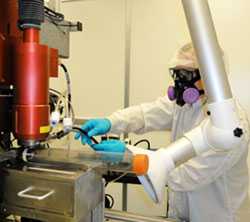GLOBAL COLLABORATIONS
Program Goals
 A key leadership role for the Global Collaborations Program is the development of goals for the Global Collaborations Program. The Global Collaborations Program is in the process of developing goals to guide NIOSH research and partnership efforts over the next decade.
A key leadership role for the Global Collaborations Program is the development of goals for the Global Collaborations Program. The Global Collaborations Program is in the process of developing goals to guide NIOSH research and partnership efforts over the next decade.
NIOSH Program Portfolio Approach
NIOSH organizes its research, guidance, information, and service efforts into specific programs that can be readily communicated and strategically governed and evaluated. Ten sector programs represent industrial sectors, and seven cross-sector programs are organized around health and safety outcomes. There are also numerous core and specialty programs that represent special emphasis areas, methodological approaches, core activities and legislatively mandated programs.
The sector programs intersect with cross-sector programs in a matrix-like fashion, with relevant Core and Specialty Programs playing a supporting role. For example, an Agriculture, Forestry and Fishing Program goal of reducing farm-related deaths and injuries due to tractor rollovers and trucks would likely be a shared goal with the Traumatic Injury Prevention Program and if appropriate would be adopted by both programs. This approach provides an added advantage and will allow multiple programs to work towards accomplishment of intersecting NIOSH goals.
Below are the current goals for the Nation developed during the second decade of the National Occupational Research Agenda (NORA)
Global Collaborations Program Strategic Goals
Strategic Goal 1: Enhance global occupational safety and health through international collaborations (This is the third strategic goal of the NIOSH Strategic Plan 2016-2020.)
Strategic Goal 2:Reduce silicosis among workers globally by providing technical assistance to control exposures and build capacity with international partners.
Strategic Goal 3: Reduce occupational road traffic injuries worldwide by collaborating with global partners to develop effective strategies.
Strategic Goal 4: Improve the health and safety of health care workers through global partnerships and practices that implement, evaluate, and coordinate training programs.
Strategic Goal 6:Improve global mining safety and health by collaborating with international partners to develop, transfer, or otherwise apply technology, training, and best practices to mining and mineral processing.
(Note: Strategic Goal 5 was retired in 2014.)
- Page last reviewed: January 9, 2017
- Page last updated: January 9, 2017
- Content source:
- National Institute for Occupational Safety and Health Office of the Director


 ShareCompartir
ShareCompartir